[UPDATE: Patrick McHale, the writer and show runner, was kind enough to chat with me, and you can read our conversation here.]
[And, please, if you haven’t seen Over the Garden Wall and you like my site, make it a point to watch it before October 31. It’s my favorite Halloween special, even more than It’s the Great Pumpkin, Charlie Brown! It’s also one of my favorite animations of any kind — simply wonderful in every way.]

Over the Garden Wall earns its charm from a mix of nostalgia, mystery, and humor. Those are the same things I love about vintage postcards. I didn’t make that connection the first time I saw the miniseries.
But the next year when I was browsing through my old Halloween cards, it hit me how similar a lot of the images used in OTGW were to the things I share.
Then I finally watched “Tome of the Unknown,” the first pilot made by Patrick McHale (creator) and Nick Cross (art director). I saw old John Crops and his vegetable/fruit car, and I knew it couldn’t just be a coincidence.
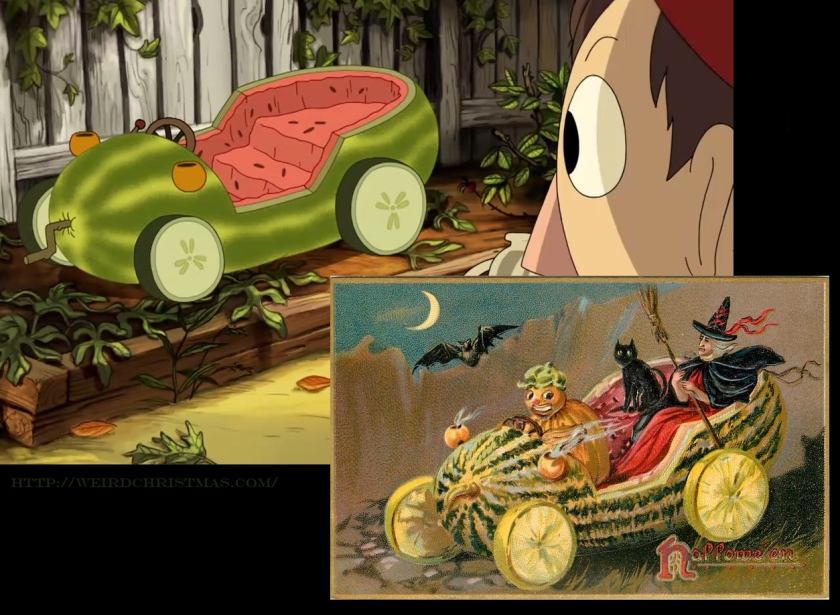
The shape of the cut in the watermelon, the multiple layers for seats, the cucumber wheels, the gourds/headlight/mirror-things, the way they turned the stem into a crank, I mean even the camera/viewpoint angle: it was a plain match. And that’s a pretty popular card, too — so much that people have made actual models of it — so it’s no stretch to think McHale had seen it.
Then The Art of Over the Garden Wall came out, and it confirmed what was pretty obvious by this point: McHale had used a lot of these old cards when developing the style of the show.

Some episodes show a stronger influence than others. And that makes sense since each one is supposed to be a different mini-adventure in a different part of the Unknown. But now I had a project: I went through my collection to find examples of the kinds of things McHale might have had in mind for different parts of the show. And I was thrilled by how much I found.
Please know that I’m not at all suggesting they somehow “stole” these ideas. The show is intentionally borrowing from all kinds of old styles and moods and reproducing them in this new world. Plus, as Art of… makes plain, by the time anything actually made it onto the screen, it had been through a host of concept artists, storyboarders, animators, and freelancers, so to suggest than any one idea came specifically from one source is ludicrous.
But to it. I don’t have cards relating to every episode, but I’m still looking. And if anyone else has good finds, please let me know (weirdxmas@gmail.com).
“The Tome of the Unkown” (Pilot)
I already mentioned the car, but John Crops himself is a throwback to a really popular trope of vegetable people that you can find all over old postcards and turn of the century advertisements.

The folk in the “big city” and the band entertaining them also fit the bill.

And, of course, John Crops’ new love is a pretty dead ringer for these folk, too.

Series Intro/Outro
The montages at the beginning and end of the series have a few nods to the old cards. The one that hits closest, though, is the turkey wagon:
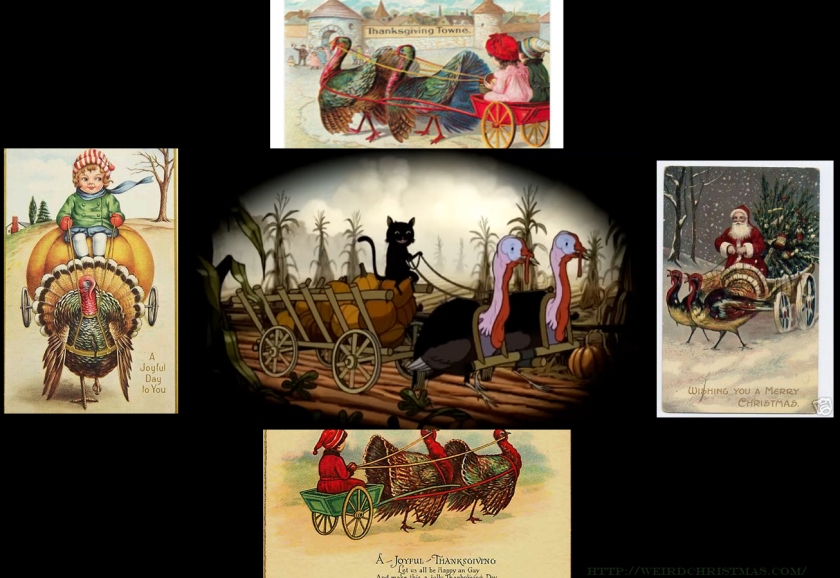
Now (spoiler, I guess), in the final outro, we find out that Enoch, the pumpkin leader guy from the second episode, is actually a black cat, probably the one driving the pumpkins up above. But he pops up out of the Enoch pumpkin.
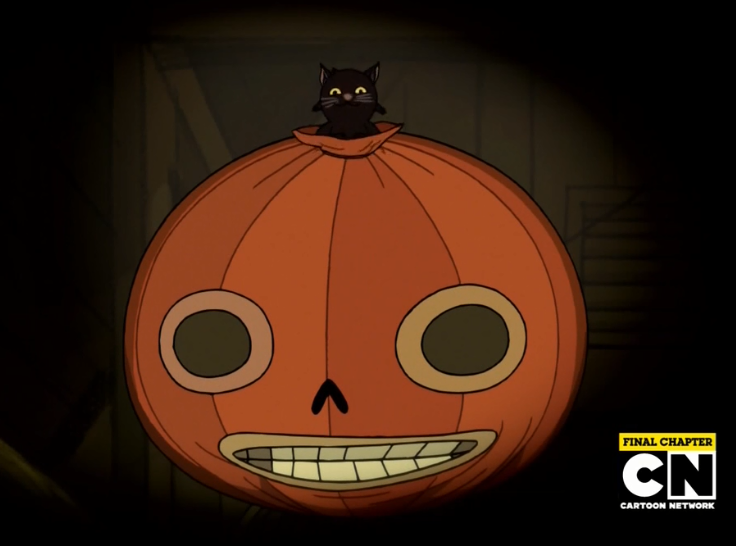
Whatever else we think that means in terms of fan theories, it’s an idea that’s all over the cards. And, granted, black cats and pumpkins are pretty standard Halloween images, so it’s no surprise they’re matched up. But just take a look at a few of these:
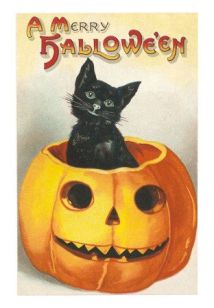


Something about cats being in charge of pumpkins or having some kind of dominance over them is definitely a trend. And, for some reason, this one just makes me think of Enoch:

“The Old Grist Mill” (Episode 1)
The first episode doesn’t have much to do with the old cards, but I think it’s odd how similar Wirt’s hat is to this card that’s always bugged me. Plus, with the whole anthropomorphized black cat thing with Enoch…who knows?
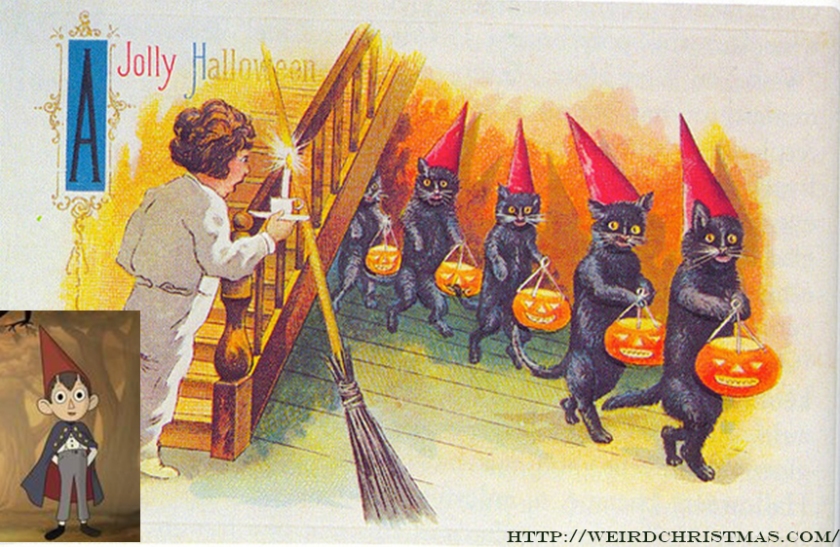
Otherwise, I feel the first episode pretty much has its own vibe.
“Hard Times at the Huskin’ Bee” (Episode 2)
McHale says that this is one of the first episodes that they produced, despite airing second, so it makes sense that it probably owes most to the postcards for its mood.
First, many of the older Halloween cards (and often the Thanksgiving ones) try to create a nostalgic sense of early rural American autumn. The cornfield, the barn, and even the empty field where Wirt has to dig at the end all have a generally similar feel to the mood that many of the cards are going for.

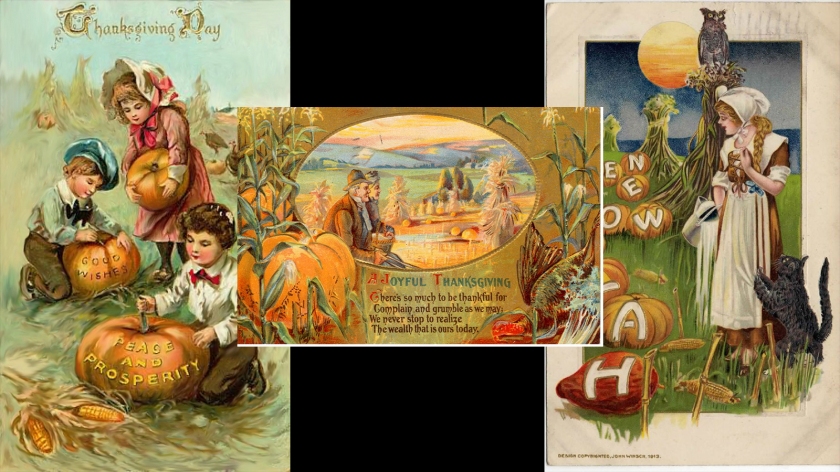
But the strongest connection is of course the pumpkin people of Pottsfield. And Nick Cross says that many of them were straight from the cards:
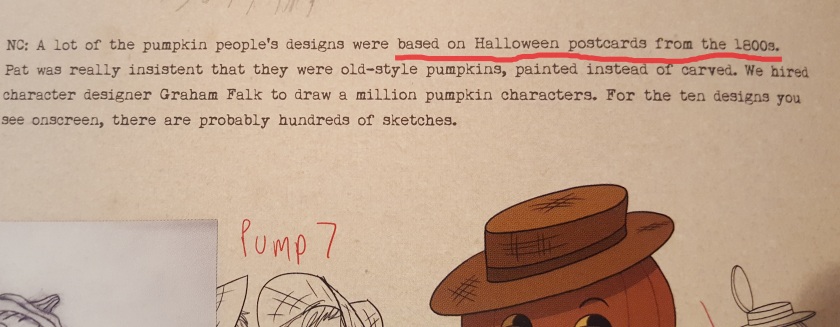
Enoch’s pumpkin is definitely a “painted-on” pumpkin instead of a carved jack-o-lantern, and the citizens are a mix of paint and carved. But the one guy that just smacks me in the face as so close to one of the cards is this one:

For the others, “pumpkin people” were all over the Halloween cards. The thing that makes the connection to the Pottsfield people closer than just a pumpkin head, though, are the arms and legs that seem sometimes like wrapped limbs of hay.

There’s also this fun similarity with the pumpkin/cat dance:
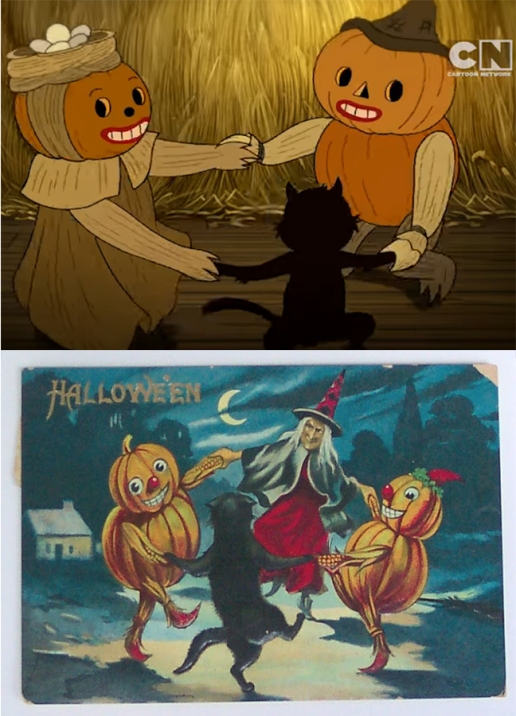
There’s also a moment that goes by so fast, it easy to miss: two pumpkins are peeling apples, and then they throw the peels over their shoulders. But they’re not just throwing the peels on the ground. There was an old Halloween party game where you could find out the identity of your future lover by peeling apples and throwing them on the ground. It was a big theme of many of the old cards, and I wrote about it here. But these two pumpkin-lovers are obviously playing this game with each other:

Enoch in his full costume also looks a bit like a few cards that put a pumpkin head on top of big stalk of, I assume, corn:
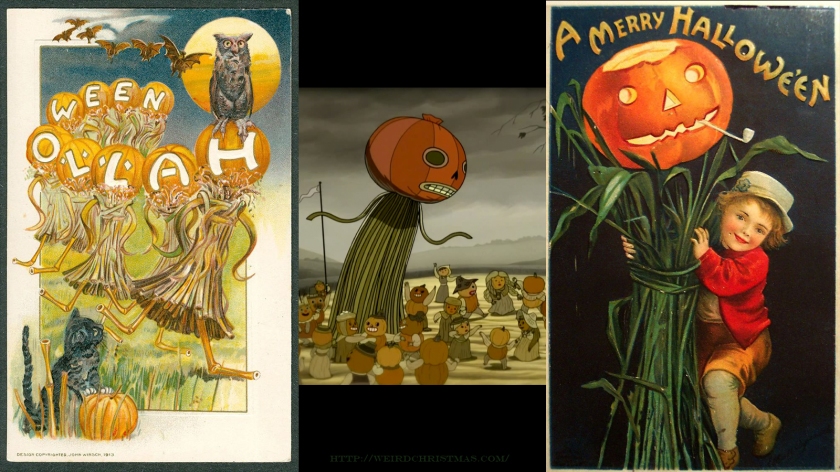
On top of that, there are just a bunch of old, weird cards out there that seem Pottsfield-esque.



“Schooltown Follies” (Episode 3)
According to Art of…, “Schooltown Follies” draws inspiration from a lot of different sources: “There was a lot of talk about Our Gang, Anne of Green Gables, and Shirley Temple while making this episode” (101). McHale also mentions Dogville Comedies, old shorts made with real dogs in human clothes. And Richard Scarry’s childrens’ books are also pretty clear analogues.
That said, there are still a few old cards that show similar things:
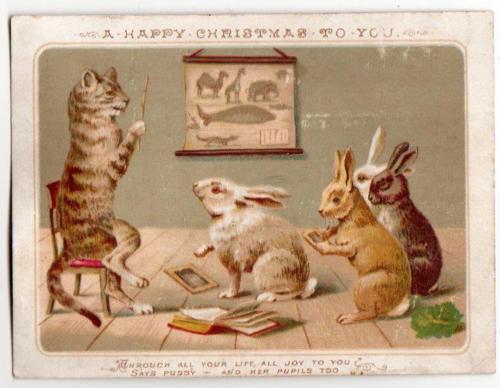
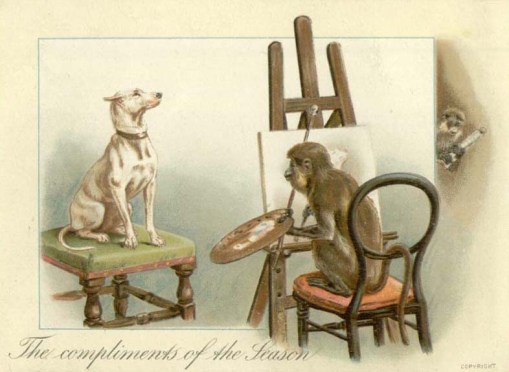
I would love to find a card with potatoes and molasses on it, tho…
“Songs of the Dark Lantern” (Episode 4)
This episode is another that’s doing something quite different from the vibe of most of the old cards. But I did come across one thing that I couldn’t help but compare the Highwayman.

“Mad Love” (Episode 5)
On this one, I have to admit that I’ve come up blank. McHale says that it began as a dream he’d had, and I’ll leave it at that.
“Lullaby in Frogland” (Episode 6)
McHale mentions an odd stop-motion video called Frogland as one of the main inspirations for this episode. But anthropomorphic frogs were a huge part of the old postcards, something I’ve talked about before. I also know that he posted an image from the McLoughlin Brothers company on his twitter awhile back, saying that their style was a big influence on this episode.
But there are so many cards showing frogs in fancy dress and/or playing instruments that it can’t hurt to share a few here.







“The Ringing of the Bell” (Episode 7)
Auntie Whispers is my favorite character of the series. I actually think she’s a nod to Studio Ghibli and Spirited Away in particular (Yubaba), something that this video brings up as well.
But there are a couple of cards that just seem like Auntie to me, whether or not they had anything to do with her.

There are also a few “hearth” cards that seem a bit like Whispers’ house.

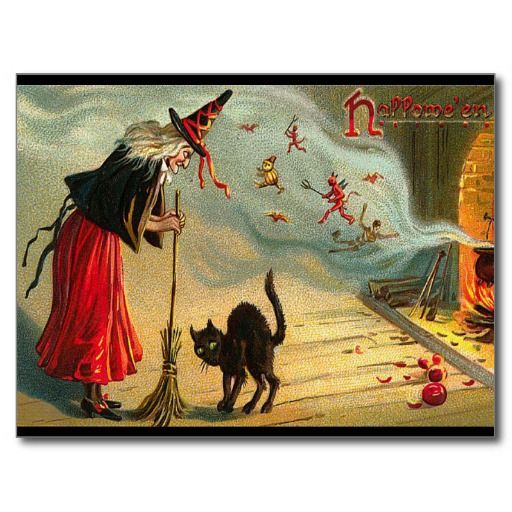

If only I could find old cards with small, black turtles…
“Babes in the Wood” (Episode 8)
Most of this episode was a nod to an old sentimental opera about children lost in the woods. It came back in animation as Hansel and Gretel: An Opera Fantasy and the Silly Symphony short Wynken, Blynken and Nod.
But one small detail is straight from the old postcards: the disembodied angel heads.

And there are indeed a ton of cherubs that are depicted on these cards as completely disembodied heads with wings.

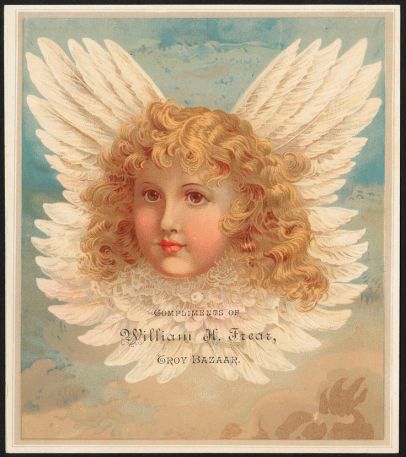

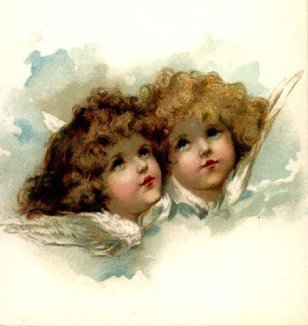
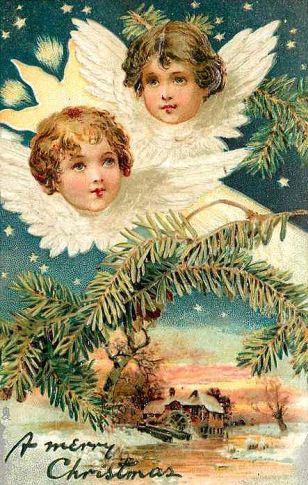
“Into the Unknown” (Episode 9)
Since this episode is a flashback to the “real” world, there’s not much nostalgia for early Americana going on (or at least pre-70s/80s). However, on the DVD commentary, McHale says that they modeled a bunch of the kids’ Halloween costumes on images of old costumes they found online (and I’ve posted my share here). He mentions the egg girl’s costume in particular, and I’m pretty sure this is the one he means:
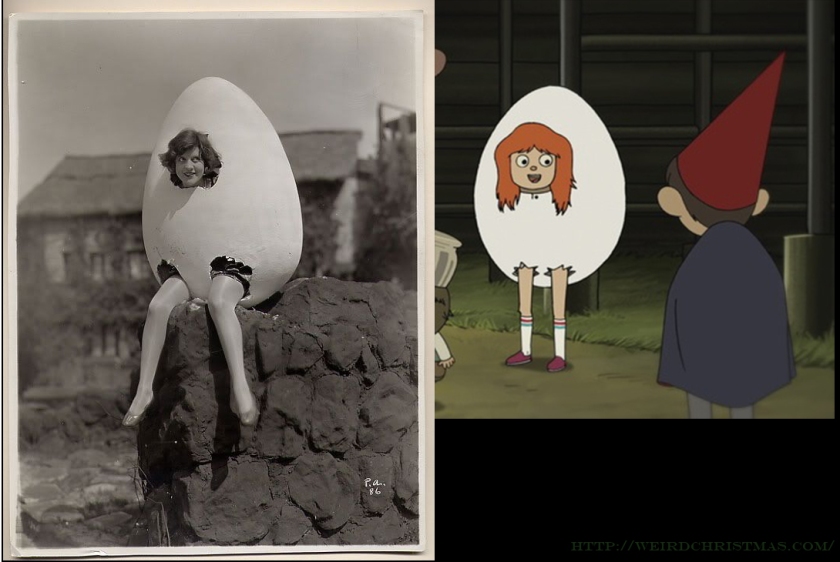
“The Unknown” (Episode 10)
Dare I say it? I don’t have anything for this one. This episode is its own beast…
Wrap Up
Were the postcards’ influence necessary to the mood of the show? As much as I’d love to say yes, I don’t think so. The throwback nods are even more about old cartoons and animation styles, but the mood and oddities in the cards were certainly part of the atmosphere that McHale was trying to create from the beginning. Personally, I was thrilled to find two things that match up so well. And, one day, if McHale or Cross ever read this, I’d love to know if they still have those cards and which ones they actually looked at during production.
Until then, though, if anyone else finds something similar, please let me know. Comment or email me at weirdxmas@gmail.com.
….. and if you enjoyed this post, consider buying me a coffee. It helps support the contests, podcast, and to get all the cards ultimately uploaded and searchable.


Oh this is my #1 Halloween watch as well, its just so haunting and lovely and strange. Like a weird dream that you wake up and only remember bits of, but both long and dread to get back to. I have the soundtrack and I listen to it all year, but it gets a real work out at this time (dunno why but the line in the theme that says “The Loveliest Lies of all” brings me to tears no matter how many times I hear it.
LikeLiked by 1 person
That is the best line of any of the songs, I agree. Everything about it is beautiful and touching and oddly cheerful, even when it’s creepy.
LikeLike
this is awesome I love how you break down each spisode as well
LikeLike